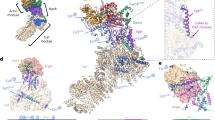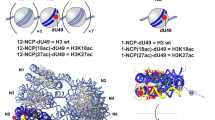Abstract
The specific post-translational modifications to histones influence many nuclear processes including gene regulation, DNA repair and replication1. Recent studies have identified effector proteins that recognize patterns of histone modification and transduce their function in downstream processes2. For example, histone acetyltransferases (HATs) have been shown to participate in many essential cellular processes, particularly those associated with activation of transcription3. Yeast SAGA (Spt-Ada-Gcn5 acetyltransferase) and SLIK (SAGA-like) are two highly homologous and conserved multi-subunit HAT complexes, which preferentially acetylate histones H3 and H2B and deubiquitinate histone H2B. Here we identify the chromatin remodelling protein Chd1 (chromo-ATPase/helicase-DNA binding domain 1) as a component of SAGA and SLIK. Our findings indicate that one of the two chromodomains of Chd1 specifically interacts with the methylated lysine 4 mark on histone H3 that is associated with transcriptional activity. Furthermore, the SLIK complex shows enhanced acetylation of a methylated substrate and this activity is dependent upon a functional methyl-binding chromodomain, both in vitro and in vivo. Our study identifies the first chromodomain that recognizes methylated histone H3 (Lys 4) and possibly identifies a larger subfamily of chromodomain proteins with similar recognition properties.
This is a preview of subscription content, access via your institution
Access options
Subscribe to this journal
Receive 51 print issues and online access
$199.00 per year
only $3.90 per issue
Buy this article
- Purchase on Springer Link
- Instant access to full article PDF
Prices may be subject to local taxes which are calculated during checkout




Similar content being viewed by others
References
Iizuka, M. & Smith, M. M. Functional consequences of histone modifications. Curr. Opin. Genet. Dev. 13, 154–160 (2003)
Bottomley, M. J. Structures of protein domains that create or recognize histone modifications. EMBO Rep. 5, 464–469 (2004)
Torok, M. S. & Grant, P. A. Histone acetyltransferase proteins contribute to transcriptional processes at multiple levels. Adv. Protein Chem. 67, 181–199 (2004)
Strahl, B. D. & Allis, C. D. The language of covalent histone modifications. Nature 403, 41–45 (2000)
Sims, R. J., Nishioka, K. & Reinberg, D. Histone lysine methylation: a signature for chromatin function. Trends Genet. 19, 629–639 (2003)
Pray-Grant, M. G. et al. The novel SLIK histone acetyltransferase complex functions in the yeast retrograde response pathway. Mol. Cell. Biol. 22, 8774–8786 (2002)
Grant, P. A. et al. Yeast Gcn5 functions in two multisubunit complexes to acetylate nucleosomal histones: characterization of an Ada complex and the SAGA (Spt/Ada) complex. Genes Dev. 11, 1640–1650 (1997)
Sterner, D. E., Belotserkovskaya, R. & Berger, S. L. SALSA, a variant of yeast SAGA, contains truncated Spt7, which correlates with activated transcription. Proc. Natl Acad. Sci. USA 99, 11622–11627 (2002)
Lee, T. I. et al. Redundant roles for the TFIID and SAGA complexes in global transcription. Nature 405, 701–704 (2000)
Huisinga, K. L. & Pugh, B. F. A genome-wide housekeeping role for TFIID and a highly regulated stress-related role for SAGA in Saccharomyces cerevisiae. Mol. Cell 13, 573–585 (2004)
Daniel, J. A. et al. Deubiquitination of histone H2B by a yeast acetyltransferase complex regulates transcription. J. Biol. Chem. 279, 1867–1871 (2004)
Henry, K. W. et al. Transcriptional activation via sequential histone H2B ubiquitylation and deubiquitylation, mediated by SAGA-associated Ubp8. Genes Dev. 17, 2648–2663 (2003)
Woodage, T., Basrai, M. A., Baxevanis, A. D., Hieter, P. & Collins, F. S. Characterization of the CHD family of proteins. Proc. Natl Acad. Sci. USA 94, 11472–11477 (1997)
Tran, H. G., Steger, D. J., Iyer, V. R. & Johnson, A. D. The chromo domain protein chd1p from budding yeast is an ATP-dependent chromatin-modifying factor. EMBO J. 19, 2323–2331 (2000)
Krogan, N. J. et al. RNA polymerase II elongation factors of Saccharomyces cerevisiae: a targeted proteomics approach. Mol. Cell. Biol. 22, 6979–6992 (2002)
Simic, R. et al. Chromatin remodeling protein Chd1 interacts with transcription elongation factors and localizes to transcribed genes. EMBO J. 22, 1846–1856 (2003)
Brehm, A., Tufteland, K. R., Aasland, R. & Becker, P. B. The many colours of chromodomains. Bioessays 26, 133–140 (2004)
Fischle, W. et al. Molecular basis for the discrimination of repressive methyl-lysine marks in histone H3 by Polycomb and HP1 chromodomains. Genes Dev. 17, 1870–1881 (2003)
Min, J., Zhang, Y. & Xu, R. M. Structural basis for specific binding of Polycomb chromodomain to histone H3 methylated at Lys 27. Genes Dev. 17, 1823–1828 (2003)
Stokes, D. G., Tartof, K. D. & Perry, R. P. CHD1 is concentrated in interbands and puffed regions of Drosophila polytene chromosomes. Proc. Natl Acad. Sci. USA 93, 7137–7142 (1996)
Kelley, D. E., Stokes, D. G. & Perry, R. P. CHD1 interacts with SSRP1 and depends on both its chromodomain and its ATPase/helicase-like domain for proper association with chromatin. Chromosoma 108, 10–25 (1999)
Bernstein, B. E. et al. Methylation of histone H3 Lys 4 in coding regions of active genes. Proc. Natl Acad. Sci. USA 99, 8695–8700 (2002)
Santos-Rosa, H. et al. Active genes are tri-methylated at K4 of histone H3. Nature 419, 407–411 (2002)
Schubeler, D. et al. The histone modification pattern of active genes revealed through genome-wide chromatin analysis of a higher eukaryote. Genes Dev. 18, 1263–1271 (2004)
Jacobs, S. A. et al. Specificity of the HP1 chromo domain for the methylated N-terminus of histone H3. EMBO J. 20, 5232–5241 (2001)
Nielsen, P. R. et al. Structure of the HP1 chromodomain bound to histone H3 methylated at lysine 9. Nature 416, 103–107 (2002)
Jacobs, S. A. & Khorasanizadeh, S. Structure of HP1 chromodomain bound to a lysine 9-methylated histone H3 tail. Science 295, 2080–2083 (2002)
Krebs, J. E., Fry, C. J., Samuels, M. L. & Peterson, C. L. Global role for chromatin remodeling enzymes in mitotic gene expression. Cell 102, 587–598 (2000)
Santos-Rosa, H. et al. Methylation of histone H3 K4 mediates association of the Isw1p ATPase with chromatin. Mol. Cell 12, 1325–1332 (2003)
Hassan, A. H. et al. Function and selectivity of bromodomains in anchoring chromatin-modifying complexes to promoter nucleosomes. Cell 111, 369–379 (2002)
Acknowledgements
We thank D. Allis and G. Hartzog for peptides, yeast strains and plasmids and for discussions regarding the design and interpretation of these experiments. We also thank J. Workman, J. Reese and S. Berger for antisera and S. Khorasanizadeh for advice on expression of the Chd1 chromodomains. P.A.G. was the recipient of a Burroughs Wellcome Fund Career Award in Biomedical Sciences. J.A.D. is supported by a predoctoral cancer training grant from the University of Virginia Cancer Center. This work is supported by the NCRR Yeast Center and an NIDDK grant to P.A.G.
Author information
Authors and Affiliations
Corresponding author
Ethics declarations
Competing interests
The authors declare that they have no competing financial interests.
Rights and permissions
About this article
Cite this article
Pray-Grant, M., Daniel, J., Schieltz, D. et al. Chd1 chromodomain links histone H3 methylation with SAGA- and SLIK-dependent acetylation. Nature 433, 434–438 (2005). https://doi.org/10.1038/nature03242
Received:
Accepted:
Published:
Issue Date:
DOI: https://doi.org/10.1038/nature03242
This article is cited by
-
Diverse and dynamic forms of gene regulation by the S. cerevisiae histone methyltransferase Set1
Current Genetics (2023)
-
Bivalent Regulation and Related Mechanisms of H3K4/27/9me3 in Stem Cells
Stem Cell Reviews and Reports (2022)
-
Histone 3 lysine 4 monomethylation supports activation of transcription in S. cerevisiae during nutrient stress
Current Genetics (2022)
-
Conservation and diversity of the eukaryotic SAGA coactivator complex across kingdoms
Epigenetics & Chromatin (2021)
-
Hippocampal epigenetic and insulin-like growth factor alterations in noninvasive versus invasive mechanical ventilation in preterm lambs
Pediatric Research (2021)
Comments
By submitting a comment you agree to abide by our Terms and Community Guidelines. If you find something abusive or that does not comply with our terms or guidelines please flag it as inappropriate.



